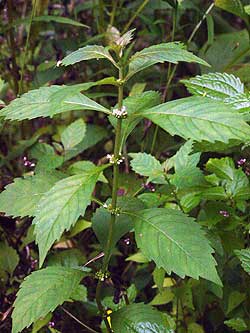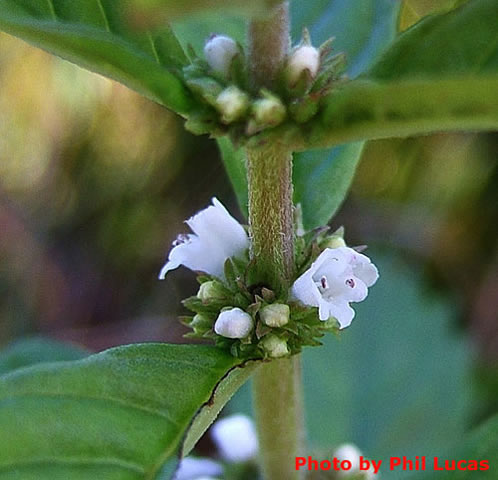The flowers are very small, white, in dense, axillary whorls; at the base of each flower are two small, subulate bracts. The corolla is campanulate, 4-cleft, the tube as long as the calyx, upper segment broadest, and emarginate. The calyx is tubular, 4-cleft, longer than the achenia. Stamens 2, distant, diverging, and simple; anthers erect and bilobed; ovary superior and 4-angled; style straight and slender; stigma bilobate; achenia 4, smooth, obovate, obliquely truncate at apex, compressed, and margins thickened.
History.—Lycopus belongs to a class of perennial herbs somewhat resembling the mints, but lacking their aroma and having but 2 perfect stamens. It is found growing in almost all parts of the United States, being very common, and preferring moist, shady places, showing particular fondness for wet, boggy soils. It grows from 6 to 18 inches in height, and, like most labiate plants, has a straight, smooth, square stem (obtusely 4-angled), with concave sides, supporting opposite, oblong, ovate or lanceolate, serrately-toothed leaves, having on their under surface small, glandular dots. The entire plant is smooth and the stem occasionally sends off long, slender runners. The flowers, which appear in midsummer (July and August), are very small, and arranged in dense, axillary whorls, or capitate clusters of a white color. The whole plant has an agreeable, yet peculiar balsamic, terebinthinate odor, and to most persons, a disagreeable, slightly bitter, balsamic taste. Its virtues are supposed to depend upon a volatile oil and tannin.

We have evidence that this plant was used early in the present century as a medicine. Schoepf, Ives, and Zollikoffer mention it. In 1828, Rafinesque, whose works were prominently recognized by the early Eclectics, notwithstanding the many liberties he took in his writings on scientific subjects, gave the best account of its introduction into medicine. He wrote of it that it was an excellent sedative, subtonic, subnarcotic, and subastringent. He further states that it is described as partaking of the properties of digitalis, sanguinaria, cimicifuga, and spigelia; but it is neither diuretic nor anthelmintic, and is rather one of the mildest and best narcotics in existence." The same author claimed "it acts somewhat like digitalis without producing any of its bad effects or accumulating in the system." He complains that volumes have been written on fox-glove, a rank poison, while this excellent substitute has been allowed to pass almost unnoticed.
 Northern Bugleweed
Northern Bugleweed